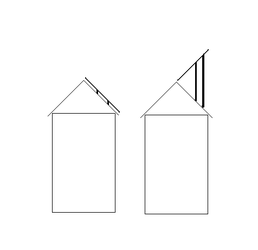Thanks hafa and everyone!
Looking at the dimensions of individual solar panels, they seem to average 60"x36" each, meaning I could fit at least one array on each roof slant, assuming it's about 60" long and the house ~12 feet in length=an Epu. Using the Pythagorean theorem, their loft height is 3'8" and 6' wide, so I did sqrt (3^2*3.67^2)=sqrt 22.4=~4.7ft~56" and I saw some panels under 60", plus I didn't take into account additional wall width that'd add to the base and thus hypotenus, so it'd probably fit on a Tumbleweed Tarleton! I'm not sure if two arrays, one on each side would be better than a tracker, though if cloudy days at a static angle would result in less than 1Kw, or worse- less than 600w/h/ day, then I'd definitely measure the monthly lows before buying a tracker or another array to find out my minimum needs (Edit: I just noticed you said aprox. 12 panels can be bought in place of one tracker and installation, so I'd probably go w/ as many panels as I can fit). One record month, when I used to live in a small studio, I had a ComEd bill with an average of 1.6kwhs/day- I used about 3 CFLs, a 225w mini-fridge, a ceiling fan (I had an air conditioning unit, but the ceiling fan was cool enough), an Eee PC <15w, a microwave, and toaster that I used once a day each for less than 2, 5 minutes, so I'm definitely up for the challenge again. Granted, my laundry and furnace heat were not included in that, plus I plan to do some real cooking, so I'd probably go with at least two arrays...very interesting what that will produce...
Thanks hafa and everyone!
Looking at the dimensions of individual solar panels, they seem to average 60"x36" each, meaning I could fit at least one array on each roof slant, assuming it's about 60" long and the house ~12 feet in length=an Epu. Using the Pythagorean theorem, their loft height is 3'8" and 6' wide, so I did sqrt (3^2*3.67^2)=sqrt 22.4=~4.7ft~56" and I saw some panels under 60", plus I didn't take into account additional wall width that'd add to the base and thus hypotenus, so it'd probably fit on a Tumbleweed Tarleton! I'm not sure if two arrays, one on each side would be better than a tracker, though if cloudy days at a static angle would result in less than 1Kw, or worse- less than 600w/h/ day, then I'd definitely measure the monthly lows before buying a tracker or another array to find out my minimum needs (Edit: I just noticed you said aprox. 12 panels can be bought in place of one tracker and installation, so I'd probably go w/ as many panels as I can fit). One record month, when I used to live in a small studio, I had a ComEd bill with an average of 1.6kwhs/day- I used about 3 CFLs, a 225w mini-fridge, a ceiling fan (I had an air conditioning unit, but the ceiling fan was cool enough), an Eee PC <15w, a microwave, and toaster that I used once a day each for less than 2, 5 minutes, so I'm definitely up for the challenge again. Granted, my laundry and furnace heat were not included in that, plus I plan to do some real cooking, so I'd probably go with at least two arrays...very interesting what that will produce...
Edit 2: I also noticed you wrote a minimum of 4 panels in each array. I probably could fit 5 panels on each side, which is 15'. There's little room in these buildings, though the ones larger than the Epu (89sq ft) are 117sq ft (Tarleton and Lusby), and feature closets near the front- I know this is a bit off topic, but those larger models have 2 extra closets plus a 2nd storage loft which might actually serve well for batteries, though it looks like some batteries need ventilation (your doors feature them), so I'd take a while to figure out which batteries I would end up choosing, though AGM ones seem nice. I'm curious what electric car manufacturers are using for their batteries, as maybe there's a technology there that isn't too different. I'm looking considering many types of batteries, like lithium and Nickel-Fe...

